

Google is now a more trusted source of news than the websites it aggregates. Here is some sobering news for anyone in the journalism industry: Online search engines have overtaken traditional media as the most trusted source for general news and information, according to a global survey of 27,000 people by Edelman, a public relations firm.

The data will be presented to delegates at the World Economic Forum in Davos this week. The trust gap between traditional media and search engines is even more pronounced among millennials. The biggest search engine is, of course, Google. And the striking thing is that Google does not actually report on anything, but instead serves up links to stories on a mix of other sites that users, apparently, trust less than the aggregator itself. Perhaps more reassuring, from the journalist’s perspective, is that traditional media are still more trusted than the flotsam and jetsam on social media, according to the study, although faith in the latter is rising quickly. Le numérique apporte une formidable audience qu'il faut monétiser. Le colloque NPA-Le Figaro a demandé aux patrons des groupes audiovisuels de réfléchir sur les transformations de leur secteur à l'horizon 2020.
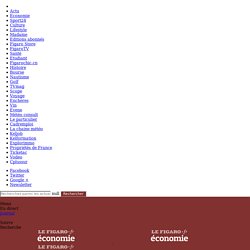
À quoi ressembleront les médias d'ici à 2020? C'est à cette question qu'ont dû répondre les nombreux invités du colloque NPA, organisé en collaboration avec Le Figaro ce mardi à Paris. Le succès de Deezer et Spotify dans la musique puis celui de Netflix dans le cinéma et la télévision ont donné le ton: l'avenir des contenus sera dématérialisé et en accès illimité. «Si ces offres marchent, c'est parce qu'elles répondent à une attente des internautes. Le prix est vu comme juste, il n'y a aucun engagement, et l'expérience client est bonne», souligne Laurence Sonzogni-Delgado, directrice des contenus chez Bouygues Telecom.
Les algorithmes utilisés par Netflix, qui analysent ce que l'internaute aime regarder pour lui proposer automatiquement des films et séries adaptés à ses goûts, «ne sont pas suffisants. Rôle de la démographie. Fungible. We don’t realize how much news media has changed in the past fifteen years.
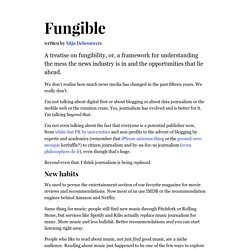
We really don’t. I’m not talking about digital first or about blogging or about data journalism or the mobile web or the curation craze. Yes, journalism has evolved and is better for it. Journalism’s biggest competitors are things that don’t even look like journalism. Ever since the web was invented, newspapers and other media entities have had to continually expand their view of who their competition is: in the good old days it was other newspapers, and then TV, and then after the web it became other news websites, or maybe Yahoo or Google.
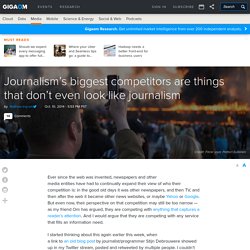
But even now, their perspective on that competition may still be too narrow — as my friend Om has argued, they are competing with anything that captures a reader’s attention. And I would argue that they are competing with any service that fills an information need. I started thinking about this again earlier this week, when a link to an old blog post by journalist/programmer Stijn Debrouwere showed up in my Twitter stream, posted and retweeted by multiple people.
News Media: Diversify or Die. InShare41 The era of news media based on single product is over.

In every field, diversification is mandatory, but yields will vary. Decisive prioritization will make a big difference. Below is a list – by no means exhaustive – of products and services to be found in most media organizations. Their targets include both individual customers (I use the term on purpose because it goes well beyond the notion of readers), as well as corporate clients. Explanatory news startup aims to build a new type of online community.
Dutch website De Correspondent responds to negative comments sections with a new kind of quality engagement In April 2013, Nieman Lab covered the story of an amazingly successful crowdfunding campaign run by Dutch startup De Correspondent, prompting New York University journalism professor Jay Rosen to tweet the link to the piece:
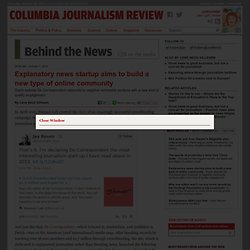
Neuze makes you wonder: What if the print newspaper had been invented after the web? Journalists I know started circulating a link this past weekend to a website offering an enticing new service known as Neuze.
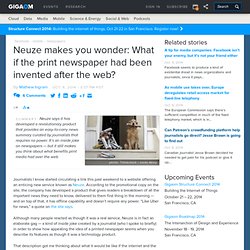
According to the promotional copy on the site, the company has developed a product that gives readers a breakdown of all the important news they need to know, delivered to them first thing in the morning — and on top of that, it has offline capability and doesn’t require any power. The newsonomics of the millennial moment. He new wave of news sites all look like they do different things.
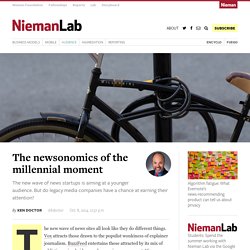
Vox attracts those drawn to the populist wonkiness of explainer journalism. BuzzFeed entertains those attracted by its mix of addictive animal videos and a growing news report. Vice entrances with adventurous, less-filtered news video, while Fusion provides both irreverence and context on the news of the day.
What they have in common is more important that what differentiates them: They all aim to get significant shares of the millennial market. It’s a market — similarly sized to the baby boomers who reshaped selling and buying — that has come of marketing age. At that size, this generation will spend $200 billion annually by 2017 (and $10 trillion in their lifetime) in the U.S. alone. Les deux tiers des Français consultent la presse chaque jour (étude)
La presse se cherche, les marques se maintiennent. Près de 49,7 millions.
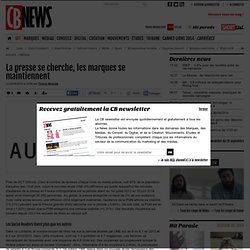
C'est le nombre de lecteurs chaque mois du média presse, soit 97% de la population française des 15 et plus, selon la nouvelle étude ONE d'AudiPresse qui publie aujourd'hui les résultats d'audience de la presse en France métropolitaine sur la période allant du 1er juillet 2013 au 30 juin 2014, après avoir interrogé 35 293 personnes.
Au global, la presse enregistre un recul de 2% de son audience. Content vs. service — Whither news? One secret to the success of Quartz, BuzzFeed and Gawker: They look at news as a service. The End of Theory: The Data Deluge Makes the Scientific Method Obsolete. But faced with massive data, this approach to science — hypothesize, model, test — is becoming obsolete.
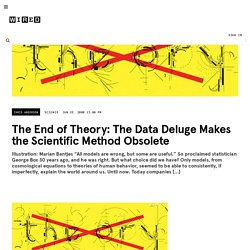
Consider physics: Newtonian models were crude approximations of the truth (wrong at the atomic level, but still useful).